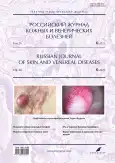Experience of successful use of intense pulsed light in the treatment of Shamberg patients
- Authors: Arkatova E.A.1, Sidorenko O.A.1, Sidorenko E.E.1, Materikin I.A.2
-
Affiliations:
- Rostov State Medical University
- I.M. Sechenov First Moscow State Medical University (Sechenov University)
- Issue: Vol 26, No 6 (2023)
- Pages: 635-644
- Section: DERMATOLOGY
- URL: https://journal-vniispk.ru/1560-9588/article/view/254773
- DOI: https://doi.org/10.17816/dv595911
- ID: 254773
Cite item
Abstract
Schamberg's disease (chronic purpura pigmentosa) is the most common type of pigmentary purpuric dermatosis, most commonly seen in men and primarily affecting the areas of the tibia, thighs, buttocks, trunk, or upper extremities, with a classic presentation characterized by petechiae, purpura, and enhancement skin pigmentation. This is a benign disease that is often asymptomatic and requires treatment if there are associated symptoms or if the patient wishes to improve a cosmetic defect.
Schamberg's disease is usually not difficult to diagnose, but its treatment can be challenging. The current standard of treatment for chronic purpura pigmentosa includes systemic and external drug therapy, correction of identified concomitant diseases that can maintain and worsen the course of cutaneous vasculitis. There are many other, including non-pharmacological, methods described in the literature, few of which have been shown to be effective. Considering the small number of studies on this topic, numerous exacerbations and the possibility of spontaneous resolution of the disease, patients’ concerns about residual pigmentation, the search for an optimal therapeutic approach remains an urgent task.
This article describes the experience of using broadband pulsed light in the treatment of Schamberg disease in a 34-year-old man. The equipment settings, diagram and exposure protocol for broadband pulsed light are presented. As a result of a follow-up examination carried out 1 month after treatment, a positive dynamic of the therapeutic process was determined: there were no new rashes, individual foci of the rash regressed completely, the remaining elements of the rash paled significantly. At a follow-up examination, four months after the therapy, a stable treatment result was recorded.
Full Text
##article.viewOnOriginalSite##About the authors
Ekaterina A. Arkatova
Rostov State Medical University
Author for correspondence.
Email: arcatova@gmail.com
ORCID iD: 0000-0001-6966-4153
SPIN-code: 7478-5709
Russian Federation, 29 Nakhchivansky lane, 344022 Rostov-on-Don
Olga A. Sidorenko
Rostov State Medical University
Email: ola_ps@mail.ru
ORCID iD: 0000-0002-7387-2497
SPIN-code: 2209-0521
MD, Dr. Sci. (Med.), Professor
Russian Federation, 29 Nakhchivansky lane, 344022 Rostov-on-DonElizaveta E. Sidorenko
Rostov State Medical University
Email: liza_11.94@mail.ru
ORCID iD: 0000-0002-9954-2920
SPIN-code: 4182-6358
Russian Federation, 29 Nakhchivansky lane, 344022 Rostov-on-Don
Ivan A. Materikin
I.M. Sechenov First Moscow State Medical University (Sechenov University)
Email: Materikin.ia@mail.ru
ORCID iD: 0009-0008-8948-0296
SPIN-code: 8710-2627
Russian Federation, Moscow
References
- Taketuchi Y, Chinen T, Ichikawa Y, Ito M. Two cases of unilateral pigmented purpuric dermatosis. J Dermatol. 2001;28(9):493–498. doi: 10.1111/j.1346-8138.2001.tb00018.x
- Sardana K, Sarkar R, Sehgal VN. Pigmented purpuric dermatoses: An overview. Int J Dermatol. 2004;43(7):482–488. doi: 10.1111/j.1365-4632.2004.02213.x
- Zaldivar Fujigaki JL, Anjum F. Schamberg disease. In: StatPearls [Internet]. Treasure Island (FL): StatPearls Publishing; 2023.
- Zvulunov A, Avinoach I, Hatskelzon L, Halevy S. Pigmented purpuric dermatosis (Schamberg’s purpura) in an infant. Dermatol Online J. 1999;5(1):2.
- Federal Clinical Guidelines. Dermatovenerology, 2015: Diseases of the skin. Sexually transmitted infections. 5th ed., revised and updated. Moscow: Delovoy Express; 2016. 768 p. (In Russ).
- Clinical Guidelines. Vasculitis restricted to the skin (L95). Russian Society of Dermatovenerologists and Cosmetologists; 2020. (In Russ).
- Seckin D, Yazici Z, Senol A, Demircay Z. A case of Schamberg’s disease responding dramatically to PUVA treatment. Photodermatol Photoimmunol Photomed. 2008;24(2):95–96. doi: 10.1111/j.1600-0781.2008.00337.x
- D’Ambrosia RA, Rajpara VS, Glogau RG. The successful treatment of Schamberg’s disease with the 595 nm vascular laser. Dermatol Surg. 2011;37(1):100–101. doi: 10.1111/j.1524-4725.2010.01822.x
- Hilerowicz Y, Sprecher E, Gat A, Artzi O. Successful treatment of Schamberg’s disease with fractional non-ablative 1540 nm erbium:glass laser. J Cosmet Laser Ther. 2018;20(5):265–268. doi: 10.1080/14764172.2017.1418513
Supplementary files











